

Uh oh...
It appears that you're using a severely outdated version of Safari on Windows. Many features won't work correctly, and functionality can't be guaranteed. Please try viewing this website in Edge, Mozilla, Chrome, or another modern browser. Sorry for any inconvenience this may have caused!
Read More about this safari issue.

It’s showtime in Arkansas, and Hollywood has come calling.
There is no secret the film industry is ramping up presence in the state. Actors, crewmembers and directors of the HBO series, “True Detective” spent their show’s third season shooting at locations around Northwest Arkansas and the River Valley in 2018. Currently, the state is buzzing with filmmakers scoping out venues for large and small projects.
Recent television series and films aren’t the first to shoot in and around the Ozarks on location. Matthew McConaughey and Billy Bob Thornton have starred in and made movies on location in the Delta region and southern parts of the state. The Old Mill in North Little Rock appears in the opening scene from “Gone With the Wind,” the larger-than-life 1930 classic.
These productions join a rich history of movie theaters scattered across the state, many that hold a spot on the National Register of Historic Places and that are still in operation today.

THE MELBA | 115 West Main Street, Batesville | www.melbatheater.org/
The Melba opened in 1875, a few decades before it would see motion pictures. Originally an opera house, the building went through renovations and a 1940 reopening as one of the state’s first cinemascope theaters, and once again in 2000 as a venue for concerts and weekend movies. It has also hosted the Ozark Foothills Film Festival, and the latest renovation in 2016 included fundraising for a digital projector.

THE ROYAL | 111 South Market Street, Benton | www.theroyalplayers.com/wp/
The history of The Royal reads a little bit like passages in the Old Testament. When Wallace and Lena Kauffman purchased this theater from Alice Wooten, it was called the “IMP,” for Independent Motion Pictures. The Kauffmans remodeled the building and changed the name to The Royal in 1949. In 1974, their son, Warren Lee and his wife, Mildred, took over management. In 1986, Warren Lee followed family tradition by doing the same. His son, Randy Kauffman, managed The Royal until 1996 when it was sold to actor Jerry Van Dyke.
For the next four years, Mr. Van Dyke was a key player in the management of this theater, but he eventually gave it to the Central Arkansas Community Players as their permanent home. It was a no-brainer for the company to change its name to The Royal Players.

THE RITZ THEATER | 306 West Main, Blytheville | www.artsmissco.org/
The Ritz bears a similar story for many of the theaters on this list. Opened in the early 1900s to function as an opera house, it was eventually converted to show moving pictures.
After several renovations, The Ritz was restored to its 1951 appearance, evoking memories and maintaining history in cinema. Today, The Ritz operates as a venue for live entertainment and movies. In its new configuration as the Ritz Civic Center, it is also home to the local Arts Council with various displays on view in the lobby area.

THE RIALTO in El Dorado | 117 East Cedar Street, El Dorado | www.eldomad.com/rialto-phase-2
Like other towns that became prosperous around that time, The Rialto is a remnant of days when vaudeville was king of the stage. It is one of the best surviving local examples of the Classical Revival architecture style and one of the largest performing spaces in south Arkansas. The local firm, Kolben, Hunter & Boyd designed the theater with its Egyptian Revival details at the main entry.
Having gone through a revolving history, it became part of the El Dorado Commercial Historic District in 2003. Currently, it welcomes traveling Broadway productions, film festivals, and performances of the South Arkansas Symphony Orchestra.
Plans are underway to give The Rialto a $32 million renovation as part of an effort in El Dorado to preserve historic buildings downtown in the Murphy Arts District. The investment will include quarters for an artist-in-residence and a 10,000-square-foot art gallery and exhibit space.

THE LYRIC THEATER | 113 W Rush Ave., Harrison | www.thelyricharrison.org/
As so many of the old theaters did, The Lyric screened silent films when it first opened in 1929. At that time, it was owned by D.E. and Lulu Fitton. It was J.W. Bass who turned it into a state-of-the-art theater showing “talkies,” movies with a sound as distinguished from silent films. Bass leased The Lyric back to the Fittons for them to manage. The maiden show after reopening was Broadway, the first film to gross $1 million.
One of the unique features of the theater are the murals contracted by Agnes Bass and painted by J.W. Zelm, a well-known Southern artist. Hidden for decades by fabric wall coverings, the murals were uncovered during a remodel in the 1980s. Following a closing and years of vacancy, the Ozarks Arts Council came calling. Today The Lyric serves as a monument to the passion of a community that values its history and its artists.

THE GEM | 117 W. Main Street, Heber Springs | www.gemmovietheatre.com/
Although Art Deco architecture originated a couple of decades before 1942 when The Gem opened, it was still a popular style to use for theaters. Fortunately, the style has been preserved and is a beautiful example of the days of neon and stucco.
It closed as a movie theater in the late 1970s, but its 250 seats still saw occasional use as a music hall. It was purchased in 1995 by the Cleburne County Arts Council and restored to host live performances. The lobby has been expanded to include an art gallery.

THE MALCO in Helena | 422 Cherry Street, Helena | www.visithelenaar.com/venue/malco-theater/
The Malco theater in Helena has served as both a place to see a movie and as a movie location in Arkansas. See this venue in scenes from the 2004 film, “Walk the Line,” about Arkansas’s native son, Johnny Cash.
Today, The Malco is a popular event space in downtown Helena and hosts gospel music during the King Biscuit Blues Festival every year in October.

THE MALCO in Hot Springs | 817 Central Avenue, Hot Springs
The current Malco Theater opened in 1946 on the site of the former Princess Theatre, a vaudeville and silent film venue built in 1910. The Malco continued to show films to the public until 1995 when Maxwell Blade took ownership and began an exclusive engagement with his magic show in conjunction with the Hot Springs Documentary Film Festival. In 2016, Mr. Blade began renovating, and it is currently home to the Maxwell Blade Theatre of Magic & Comedy.

THE FORUM | 115 E Monroe Avenue, Jonesboro | www.foajonesboro.org/
Built in 1926 and originally called The Strand, this was the largest theater in or around Jonesboro, Arkansas for over 40 years. It had a full-size stage, dressing rooms and restrooms, features that weren’t found in many other theaters of the time. Paramount Pictures and Malco Theaters, Inc. both owned the building during its years showing movies, but it was sold to the city in the mid-1970s.
Unlike many other towns that let their theaters fall into disrepair and neglect, Jonesboro invested in the building and restored it to maintain its function as a theater for the community. Upon reopening, the name was changed to The Forum. Eventually, three local groups got together and focused efforts to preserve and maintain arts programs. The Jonesboro Fine Arts Council, The Northeast Arkansas Symphony and The Friends of the Forum merged to become the Foundation of Arts, taking The Forum on as their home.
In 2019, a $250,000 renovation project will update the outside of the building, install new lighting and sound on the stage, and create a larger ticket booth and concessions.

THE RITZ | 213 S Main Street, Malvern | www.facebook.com/The-Ritz-Theatre-308754847008/
Although it was built in the 1930s, history at The Ritz is still being written. In January, longtime owners, Marty and Marla Nix, announced they would be closing the theater to pursue other professional opportunities. Two local businessmen, Rodney Allen, owner of Diamond State Trucking, and Dennis Nix, owner of Nix Screw Machine, donated to the College of the Ouachitas Foundation with the stipulation that the funds be used to purchase the theater.
According to the college, plans for the building include turning it into a community performing arts center and hosting College of the Ouachitas special events in the facility. The Ritz will also be made available to community members and organizations.
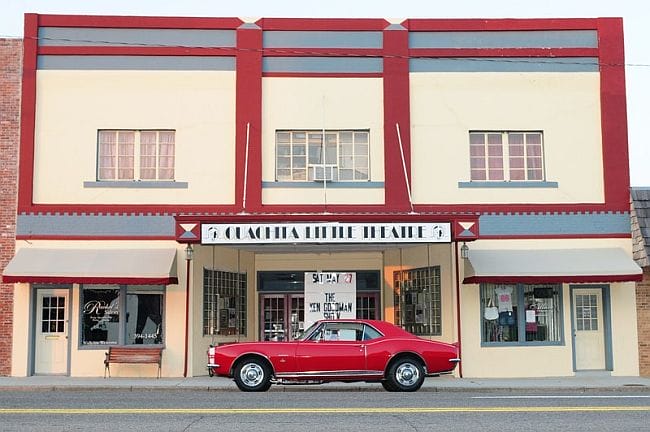
OUACHITA LITTLE THEATRE | 610 Mena Street, Mena | www.ouachitalittletheatre.org/
As the lesser-known Lyric Theater, the building that is now known as Ouachita Little Theatre (OLT) was built in 1909, and actually had three other physical locations in Mena.
Another theater showing only silent films, The Lyric was renovated in 1930 to welcome “talkies.” The first shown in the new space was Say it With Songs, starring Al Jolson. Locals and radio and movie stars, Lum and Abner also appeared on its stage. Local performers occasionally set up around the corner to present impromptu shows, which became known as Saturday Night at the Lyric. Today, the Ouachita Little Theater continues the tradition several times a year by hosting folks for those Saturday nights inside the building.
Today, the building is back to hosting Ouachita Little Theatre events and is available as a special events venue for the community.
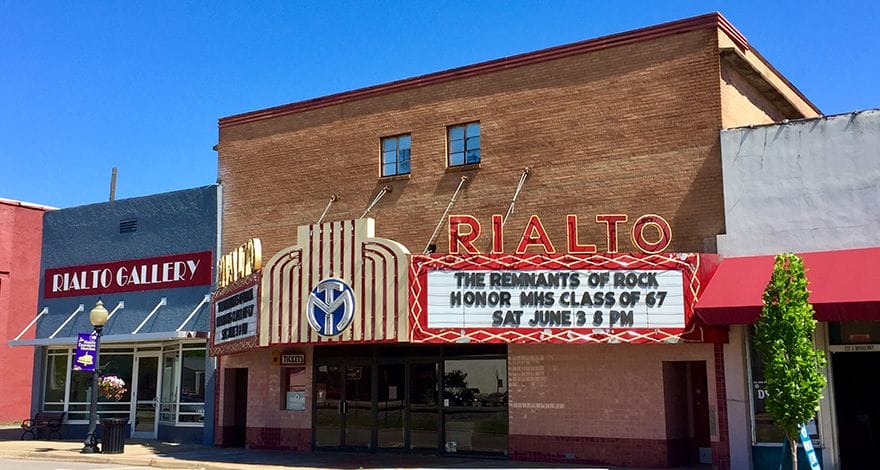
THE RIALTO THEATRE in Morrilton | 215 East Broadway Street, Morrilton | www.rialtomorrilton.weebly.com/
There are claims that this initially opened in 1911, while others say it was somewhere around 1908. Date aside, this was the first movie theater in Morrilton, Arkansas. The original owner sold it in 1925 to I.W. Nance of nearby Conway, who changed the name to The Grand Theatre, and two years later a subsidiary of Malco Theatres, Inc. purchased it and officially renamed it the Rialto Theatre.
The first movie with sound to screen was “Fast Life” in February 1930. Following a few ownership changes and renovation, the main hall was converted into three separate theaters to accommodate more film showings. The final private owner, United Artists theater chain, ceased operation in 1987 and closed the building.
It sat unused until the City of Morrilton purchased the building in 1995, and the Rialto Community Arts Center was formed the next year as part of The Arts Council of Conway County. The hall was restored to its single-screen glory, and the marquee was restored to resemble the 1950s version. Additionally, updated sound and lighting were added, and a new stage constructed.
Photo Credit: RoadArch.com

THE COLLINS THEATRE | 120 W Emerson, Paragould | www.collinstheatre.com/
Named The Capitol Theatre when built in 1925, The Collins Theatre operated as so many others have, presenting a variety of events including Broadway shows, vaudeville performances and movies to its community. The opening film was the silent film, “The Coast of Folly,” starring the queen of silent film, Gloria Swanson.
In 1936, the Collins family purchased the theater and became the sole owners-operators. They held on to the theater until deeding it to the Greene County Fine Arts Council in 1986. The council went on to develop it into a local center for the performing arts and changed the name to the Collins Theatre in memory of Frances and Orris Collins.
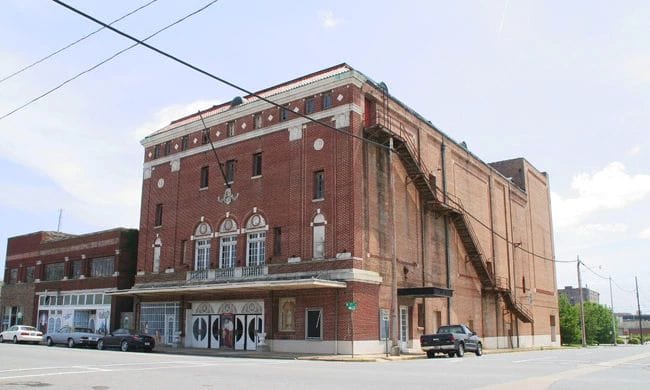
THE SAENGER THEATER | 207 W Second Avenue, Pine Bluff
The Saenger brothers built over 300 theaters through the South in the 1920s, and this one, at the time called “The Showplace of the South” is one of less than 100 of those theaters still standing today.
Before it was a theater, the building was an old store owned by O.C. Hauber. He turned the facility into Hauber Theater in 1912, and it had two other owners between that year and 1924 when it became The Saenger after it burned and the brothers rebuilt and renamed it. Costing almost $200,000, the Saenger was a palatial theater, with 1,500 seats on two levels.
Acts such as the Ziegfeld Follies and Harry Houdini performed at The Saenger, as did Roy Rogers and his horse, Trigger and humorist Will Rogers. Through the years many school plays, high school graduations and dance recitals took the stage.
After closing in 1975, renovations, the addition of painted murals to the front of the building and gold curtains donated by the Miss America pageant, the city of Pine Bluff took ownership in 2012.

VICTORY THEATER | 114-118 South Second Street, Rogers | www.arkansaspublictheatre.org/
Rogers, Arkansas became home to the first movie theater in the region when Victory Theater opened in 1927. Designed by well-known local architect A.O. Clark, it replaced an earlier theater on West Walnut and cost $35,000 to build. The first sound films were shown in the new theater in 1929. The building was vacant for many years after closing in the early 1970s, but in 2008 the City of Rogers purchased the Victory Theater, and it is now home to the Arkansas Public Theater company.

THE RIALTO in Searcy | 100 West Race Street, Searcy | www.searcyrialtotheater.com/
Like many other theaters on the list, The Rialto was built in the 1920s. It is one of only a few buildings in White County featuring Art Deco style, additions made during a 1940 update. Especially lovely is its elaborate neon marquee.
A plan for reviving the theater with a user-friendly renovation is underway via Main Street Searcy, a nonprofit devoted to downtown Searcy. An engineering plan has been created, and a capital campaign is planned for the near future.
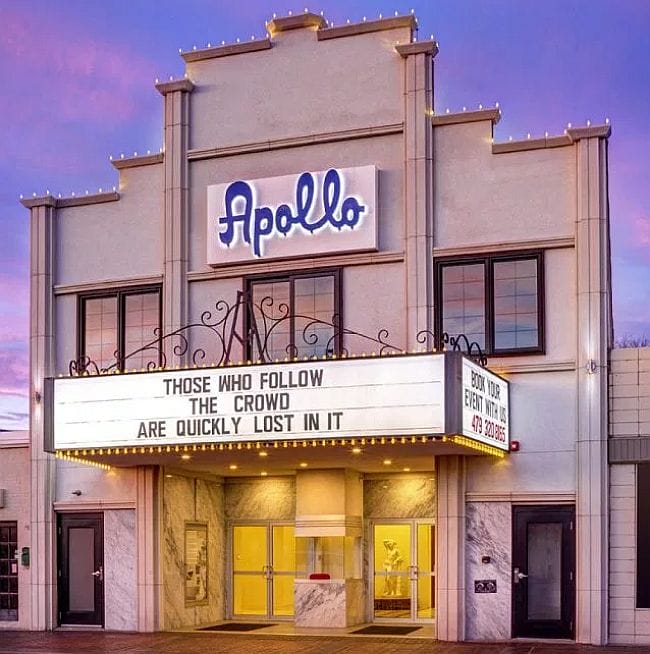
THE APOLLO | 308 West Emma Avenue, Springdale | www.theapolloonemma.com/
The naming of The Apollo is something of a local legend. In June 1948, William Sonneman announced that he would build a movie theater in Springdale, and soon after construction began in 1949, a contest was announced to name it. According to stories, a local antique dealer had a marble statue of Apollo for sale in his store. The would-be manager of the theater, Max Cox, saw the statue and suggested his boss, Mr. Sonneman, check it out. Sonneman loved it, bought it, and named his theater after it.
After an adult film debacle, the Apollo languished for years but was purchased in 1979 by Jim Ritchey. Mr. Ritchey resumed showing family-friendly movies for the next 14 years, but it closed again. In June 2014, Springdale natives Brian Moore and Tom Lundstrum formed Restore Springdale, LLC, purchased the condemned building, and brought the exterior of the building back to 1940s glory. The interior was converted into a venue space, and hosts weddings, meetings and other community events.

KING OPERA HOUSE | 427 Main Street, Van Buren | www.vanburencity.org/228/King-Opera-House
The popular 2018 musical film, The Greatest Showman, might have made Jenny Lind a household name. The King Opera House was fortunate enough to welcome Lind to its stage among countless other celebrities and performers. It’s a featured property in the Van Buren Historic District.
Since it opened doors in the late 19th century, the Victorian-era structure has undergone many restoration projects. It reopened for use in 1979, the interior having been restored with elaborate, period-correct design flourishes and details.
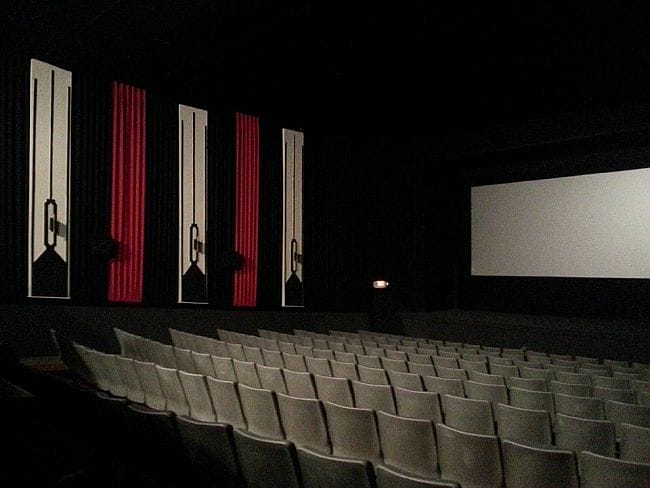
THE SCOTT THEATER | 281 S Main Street, Waldron | www.scotttheater.com
While there are many theaters still operating in some capacity, The Scott claims the distinction of being the oldest one still operating as a movie theater in the state of Arkansas. It opened in 1930 and the years since have not been without a few changes, including a name change and several renovations.
In 2015 the projection system was updated to screen state-of-the-art digital sound and video. Most recently, the 220-seat theater received an addition of 25 VIP seats for folks who are only happy with the best seat in the house.
We do the work.
You check your email.
Sign up for our weekly e-news.
Get stories sent straight to your inbox!












 Leave a Reply
Leave a Reply
@Laurie, this story is so “you”! Thank you for bringing your vintage eye and exploding beautiful stories!
[…] are remaining closed for the safety of their patrons. But even as we are missing the dark theaters and reclining seats, folks in some parts of the state have another option – drive-in theaters are […]
Hi Laurie
My name is Chris Engholm, in Bentonville. I’m a curator and photographer who put together the “House of Light” exhibit about Hugo and Gayne Preller, among others, and I was the fellow who confirmed that the artist Zelm did the great murals at the Lyric in Harrison. I have been contemplating a book project (fine art photos with stories) treating the vintage theaters of Arkansas, and since you’ve done some leg work, perhaps we should talk. I’m at 4796701983 or chris@chrisengholm.com. Take care, Chris Engholm
[…] certainly head to your local cinema to catch the latest flicks. Arkansas still has several smaller, historic theaters where you can watch a movie while enjoying the nostalgia of an old-fashioned theater experience. […]
[…] of local cinemas throughout the state where you can catch the latest blockbuster or indie flick. Historical theaters provide unique experiences, while standard cinemas offer comfortable stadium seating and even some […]
[…] Historic Theaters of Arkansas […]
my great aunt and uncle worked in a Sebastian-Arcola theater according to the federal census as an usher-manger and a cigerette girl back in 1920 as they were only in the area for 6 months on their way back to Columbus , Ohio. they lived with a border who was a corsetteer but no given address. my great aunts father was a coal mine supervisor that lived at the corner of Midland road and Huntington rd.. any idea which theater they may have worked in? August and Florence Bearhs were their names.